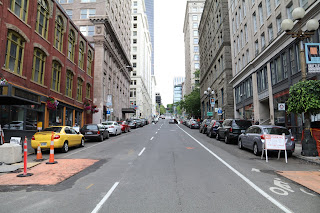In 1889 a large portion of Seattle was destroyed by fire and the city managers decided this would be an opportune time to raise the streets up out of the mud. They built retaining walls that raised the streets near Elliott Bay by one story. The walls were filled and new streets built on top. This left all the store fronts and sidewalks one story below the new streets. Consequently the citizens had to use ladders to carry their purchases from the stores below up to the street above. This turned out to be unsafe and a number of folks fell from the street above to the sidewalk below. Eventually the sidewalks were raised to the street level and the first floor of all the buildings became a basement. This left a maze of passageways under the city that today are referred to as Underground Seattle. We took a tour of Underground Seattle and some of the following photos show what we saw.
The tour started by entering a door on what was once the second story of the Korn Building. Notice the large black arrow in the second photo showing the door we entered.
Our guide explains that we are about to enter the second floor of the Korn Building
Black arrow shows the door
In the next photo our guide is showing us an artist's drawing of the Korn Building as it looked before the streets were raised. The door we entered from the present day street level was once a window on the second floor. The large black arrow in the photo below points to that window. Once below we exited thru the large front door of the Korn Building onto the sidewalks of the old streets.
Notice black arrow pointing to the door that was once a window
Here we are at the old street level. Notice the bricked up store windows.
Notice the retaining wall on the left used to raise the old street
Another example of an old store front with the window boarded up
There was a lot of old junk down there. Here is a toilet that must be a 100 years old
Here is a similar toilet in the museum that has been restored. Notice the flush tank high above.
An old bathtub in one of the passageways
In some locations skylights were installed in the new sidewalks to provide light to the area below. In the next photo notice the arch in the brick used to improve support for the new sidewalk. Remember the sidewalks were added sometime after the road level was raised.
Skylight as seen from below
The same skylight seen from above
Next to the Korn Building is the oldest restaurant in Seattle
As the streets move farther away from the bay they become very steep reminding one of San Francisco, although Seattle is not as severe.
Looking up hill from Pioneer Square













No comments:
Post a Comment